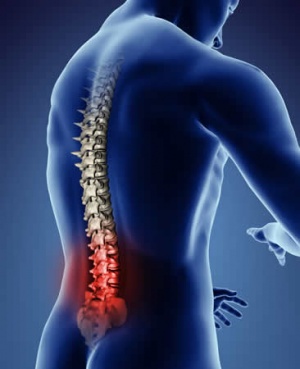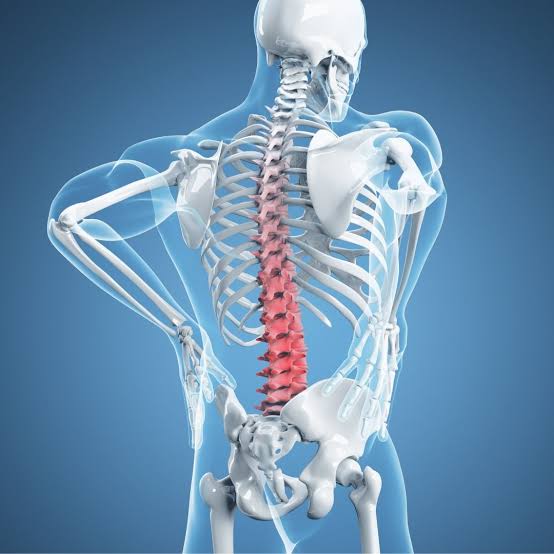Many people suffer from the common spinal ailment known as lumbar spondylosis, especially as they age. We will look at the pathology, phases, kinds, causes, risk factors, indicators, and symptoms of lumbar spondylosis in this beginner’s guide, as well as how homeopathy can treat the condition holistically. To assist you in comprehending and navigating this ailment, we will also go into the complications, differential diagnosis, general care, and preventive actions.

What is Lumbar Spondylosis?
Lower back degeneration leading to lumbar spondylosis, sometimes called lumbar osteoarthritis, is common. It mostly affects the discs that act as cushions between the lumbar vertebrae. Lower back pain and stiffness may result from the degeneration of these discs and the creation of spurs or other abnormal growths in the vertebral bones over time.
The Pathology of Lumbar Spondylosis
The progressive deterioration of the lumbar spine is the underlying pathophysiology of lumbar spondylosis. The aging process is usually the first cause of it, since the intervertebral discs become less elastic and water-filled. The discs may decrease as a result of this deterioration, reducing the space between the vertebrae. The body may react by thickening the ligaments in the impacted area and producing bone spurs, or osteophytes. These enlarged ligaments and bony growths have the potential to compress spinal nerves, causing pain and other symptoms.
Stages of Lumbar Spondylosis
Usually, lumbar spondylosis develops in multiple stages:
1. Early Stage: There could not be any symptoms at all in the early stages. Degeneration starts at this point, however it frequently shows no symptoms.
2. Mild to Moderate Stage: As the illness progresses, people may have sporadic soreness, stiffness, and lower back pain, particularly after exertion.
3. Severe Stage: People may have excruciating pain that does not go away, decreased movement, and maybe signs of nerve compression, like sciatica.
Types of Lumbar Spondylosis
Different forms of lumbar spondylosis exist depending on the particular structures that are impacted:
1. Lumbar Disc Degeneration: This is the most prevalent kind, characterized by the degeneration of the intervertebral discs, which causes pain and discomfort.
2. Lumbar Facet Joint Osteoarthritis: This kind causes discomfort and decreased flexibility due to the deterioration of the facet joints in the lumbar spine.
3. Lumbar Spinal Stenosis: This kind causes pain and other neurological symptoms when the spinal canal narrows and compresses the spinal cord or nerve roots.
Causes and Risk Factors of Lumbar Spondylosis
It is essential to comprehend the causes and risk factors of lumbar spondylosis in order to avoid and treat the condition. Aging is a major influence, but there are other causes and risk factors as well, such as:
– Genetics: Spondylosis running in the family and may raise the risk.
– Occupational Factors: The illness may be exacerbated by jobs that require heavy lifting, repeated motions, or vibration.
– Inactivity: The muscles that support the spine might deteriorate from a lack of exercise.
– Obesity: Carrying too much weight strains the lumbar spine.
– Trauma or Injury: Degeneration may be accelerated by a history of spinal trauma or injury.
– Smoking: Smoking can make it more difficult for the body to preserve and mend spinal structures.
Signs and Symptoms of Lumbar Spondylosis
Early detection and intervention of lumbar spondylosis depend on the ability to recognize its indications and symptoms. Typical signs and symptoms include of:
– Lower Back Discomfort: Lumbar spondylosis is characterized by dull, excruciating lower back pain.
– Stiffness: A decreased lower back range of motion and flexibility.
– Radiating Pain: Sciatica-like symptoms may be experienced if discomfort travels down the legs.
– Numbness and Weakness: Numbness, tingling, and weakness of the muscles might result from nerve compression.
– Difficulty Walking: In severe situations, it may be difficult to stand or walk for long periods of time.
Investigations of Lumbar Spondylosis
A combination of the patient’s medical history, physical examination, and diagnostic testing is frequently used to diagnose lumbar spondylosis. These examinations could consist of:
– X-rays: To see the bones and see any spinal canal constriction or spurs.
– Magnetic resonance imaging (MRI): This modality of imaging that produces fine-grained pictures of the spine makes it possible to evaluate disc health and nerve compression.
– A CT (Computed Tomography) Scan: This can assist in determining the degree of deterioration and provide a more thorough look of the bone structure.
– Electromyography (EMG): This test evaluates nerve function by measuring the electrical activity in muscles.
Complications with Lumbar Spondylosis
If lumbar spondylosis is not treated, it might result in many consequences.
– Chronic Pain: Suffering from chronic pain can have a major negative effect on your quality of life.
– Nerve Damage: Persistent compression of the nerve may cause irreversible harm.
– Loss of Mobility: Severe cases may result in incapacity and make it difficult to carry out routine tasks.
Differential Diagnosis for Lumbar Spondylosis
It is critical to distinguish lumbar spondylosis from other illnesses that present with comparable symptoms. The following illnesses could be mistaken for lumbar spondylosis:
– Herniated Disc: Similar to spondylosis, a bulging disc can produce discomfort and numbness.
– Dysfunction of the Sacroiliac Joint: Lower back pain may be mistaken for sacroiliac joint dysfunction.
– Fibromyalgia: This illness may cause exhaustion and extensive discomfort in the muscles.
– Inflammatory Arthritis: The spine may be affected and painfully affected by diseases such as ankylosing spondylitis.
General Management of Lumbar Spondylosis
A combination of lifestyle modifications, physical therapy, and, occasionally, medication is used to treat lumbar spondylosis. The following are a few general management techniques:
– Physical Therapy: To increase range of motion and fortify the back and core muscles, a physical therapist might create stretches and exercises.
– Medications: Anti-inflammatory medications, muscle relaxants, and over-the-counter pain medicines may help control pain and discomfort.
– Homeopathy: As we will discuss in greater detail, homeopathic remedies provide a comprehensive and all-natural means of treating lumbar spondylosis.
– Ergonomic Adjustments: You can lessen lower back strain by making changes to your living or working environment.
– Weight Management: By keeping a healthy weight, the lumbar spine can experience less strain.
The Role of Homeopathy in Treating Lumbar Spondylosis
A complementary and alternative method of treating lumbar spondylosis is homeopathy. Based on the idea that “like cures like,” it involves stimulating the body’s natural healing processes with very diluted natural ingredients. Homeopathic treatments are individualised, considering not just the patient’s physical symptoms but also their emotional and mental well-being.
Homeopathic Remedies for Lumbar Spondylosis
There are a number of homeopathic treatments that can be used to treat lumbar spondylosis. To get the best treatment for your particular problem, you must speak with a licensed homeopath. Typical treatments include the following:
1. Rhus Toxicodendron: Reduces lumbar pain and stiffness that is exacerbated by movement or hard surfaces but gets better when you sit or move around. Three pills three times a day is the dosage.
2. Aesculus Hippocastanum: Good for pain in the low back that is alleviated in cool, open air but becomes worse when one walks, stoops, or stands. Dosage: Tincture: 3C; three times a day, 10 drops in half a glass of water.
3. Bryonia Alba: Reduces lumbar strain and stiffness that gets worse with movement and becomes better with rest. Three pills three times a day is the dosage.
4. Colomynth: Reduces lumbar discomfort that radiates down the left leg and is made worse by heat and firm pressure. The pain is described as a drawing and tearing sensation. Three pills three times a day is the dosage.
5. Natrum Muriaticum: This herb relieves back discomfort that is better while lying on the right side or applying pressure to the back. It is increased by physical activity and extended standing. Three pills three times a day is the dosage.
6. Cobaltum: Beneficial for severe back pain and back pain with seminal emissions that becomes better when standing, walking, or lying down, and gets worse when sitting. Three pills three times a day is the dosage.
7. Phosphorus: Eases burning in the back and pain as if it’s broken, particularly during touch or physical exertion, and when lying on the left or painful side or ascending stairs. Dosage: 3-5 pills, 3 times a day.
8. Gnaphalium: Helps with pain extending from the lumbar region to the thighs and intense pain along the sciatic nerve, with alternating numbness and pain. Dosage: 3-5 pills, 3 times a day.
These homeopathic treatments offer a comprehensive strategy for treating lumbar spondylosis and can be customized for each patient’s unique situation. A licensed homeopath should be consulted in order to ascertain the best remedy and dosage for your specific circumstances.
General Prevention of Lumbar Spondylosis
It is always preferable to prevent than to cure. Although we cannot reverse the effects of aging, we can lower our chance of acquiring lumbar spondylosis:
– Regular Exercise: Taking part in exercises that improve core and back strength can support the spine.
– Appropriate Posture: Avoid placing undue strain on the lumbar spine by keeping your posture straight when standing and sitting.
– Ergonomic Workstations: Invest in an ergonomic workstation to lessen strain if your profession requires you to sit for long periods of time.
– Weight Management: Lower back strain can be mitigated by maintaining a healthy weight.
– Refraining from Smoking: Giving up smoking can help your body maintain and restore your spinal structures.

Conclusion: Taking a Holistic Approach to Lumbar Spondylosis
Although lumbar spondylosis can be a difficult condition to live with, a full and pain-free life is achievable with the correct care and prevention strategies. For individuals looking for a mild, customized approach to treating lumbar spondylosis, homeopathy provides a natural, holistic solution. But always seek advice from a licensed homeopath and medical expert to make sure you get the best treatment possible for your particular circumstances. Keep in mind that a thorough strategy that includes lifestyle adjustments will significantly improve your path to a pain-free, healthy back.
Reach out to us for a Consultation
For any queries, reach out to us at contact@homeopathic.ai
This blog is for information purposes. It’s crucial to note that while homeopathy is a centuries-old practice with many adherents worldwide, always consult a qualified homeopath or medical professional before initiating any treatment.





